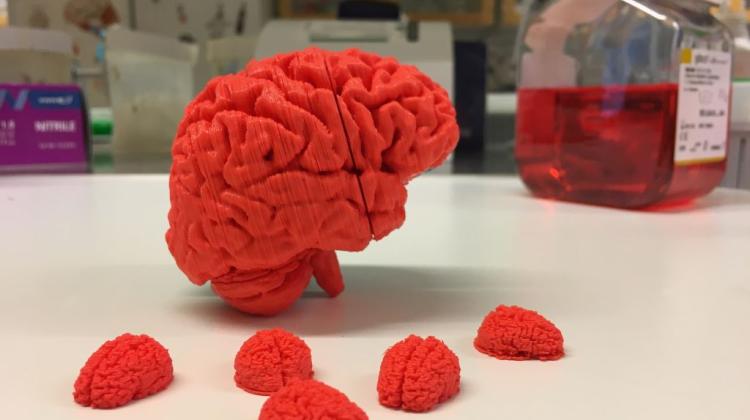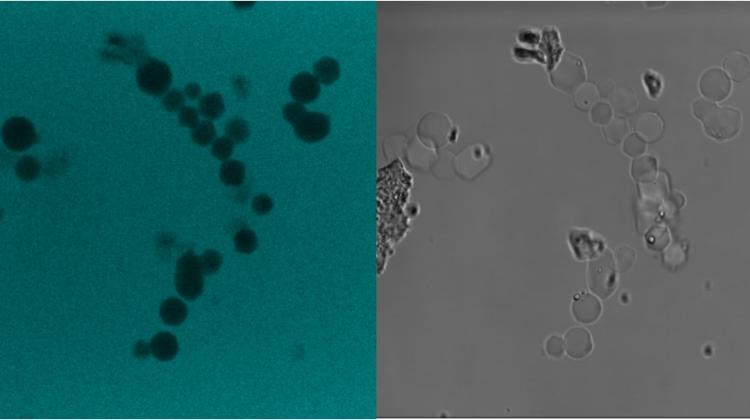Micro brains straight from the 3D printer

Millimetre-sized models of the human brain printed on a 3D printer? Scientists from Swedish Karolinska Institute are getting closer to producing them. These structures would facilitate studies of neurodegenerative diseases, pharmaceutical tests, and in the future also printing "spare parts" for the brain.
The brain is the least understood and most complex structure in the universe. "We do not know exactly how it is built, what it is built of, and we still do not understand how it works. When it comes to the brain, we do not even know how much we do not know" - told PAP Jakub Lewicki, PhD student at the Swedish Karolinska Institute.
As part of his doctoral project he is preparing a tool that will help in the studies of the brain and, among other things, the mechanisms of neurodegenerative diseases. This tool is a model of the living brain, a miniature tissue that resembles a mini brain. "Normally, when studying the brain and other organs in the laboratory, scientists use completely flat surfaces - culture plates. Then they jump straight to animal models. These studies, however, fail to sufficiently reflect the processes occurring in our bodies" - explained Lewicki.
Researchers at the Karolinska Institute want to develop a three-dimensional model of the brain. Research shows in fact that maintaining 3D structures and space is very important in laboratory cell culturing. "In our work, we use the induced pluripotent stem cells technology. We collect easily accessible skin cells from the patient and +take them back in time+ with a special genetic cocktail. As a result, they revert to stem cells, which have the potential to regenerate and build our body. We transform skin cells into stem cells, and then use them to obtain nerve cells" - Jakub Lewicki explained in an interview with PAP.
Researchers are simultaneously working on a new material, which will be used to print the entire structure. Standard 3D printing uses plastics and metals, which are not friendly to our body and cells. Scientists are looking for a material that will allow human cells to grow safely. "Once we have the perfect material, we will be able to mix it with nerve cells and produce bioink, a material which we will use to build a three-dimensional scaffold containing the nerve cells" - described Lewicki.
Such models of tissues and organs - not just the brain - will be useful primarily for testing drugs. They are already being used for such purposes to some extent. Some companies offer miniature tissues of various organs: liver or kidney, which a pharmaceutical company can order, and then feed their drug into the tissue and watch what happens to it.
But this is only the beginning of the possibilities. "We can extract cells from patients with neurodegenerative diseases: Parkinson\'s, Alzheimer\'s, Down\'s syndrome. We can use their cells to print a +sick brain+ and see what happens in such a model, how cells communicate and what is wrong in comparison with healthy tissue" - described Lewicki.
The use of stem cells will also enable a better understanding of embryonic development of the brain and the processes leading to the formation of this organ. In the future, researchers would also like to use 3D tissue to treat the brain. "We could scan a damaged brain, create a three-dimensional model of the parts that are missing, and then print and insert these missing parts. In this case, however, a much larger scale would be required, so that we could print parts for patients with traumatic brain injury or after tumour removal" - explained Jakub Lewicki.
However, each of the mini-brains will be only a few millimetres in size. "Our brain is the most complex organ we know in nature. Therefore it is better to start with a small scale, reducing the degree of complexity of the entire system. Then it will be easier to create larger structures" - noted the researcher. Cost is also an obstacle in the construction of a larger model. Both cell culture and biomaterials for 3D printing are expensive.
If the researchers at the Karolinska Institute manage to find the right materials for printing, they plan to print tens and hundreds of mini-brains. "I hope to give a good start to the project, and later my colleagues will use this technology and print more mini-brains for research purposes. Further development of this idea depends on the demand" - he noted.
PAP - Science and Scholarship in Poland, Ewelina Krajczyńska
ekr/ agt/ mrt/ kap/
tr. RL
***
The text is one of the results of the program Spokespersons of Science, organized by the Copernicus Science Centre and the British Council Foundation. The program facilitates establishing cooperation between scientists who popularise knowledge and science journalists.
Przed dodaniem komentarza prosimy o zapoznanie z Regulaminem forum serwisu Nauka w Polsce.


















